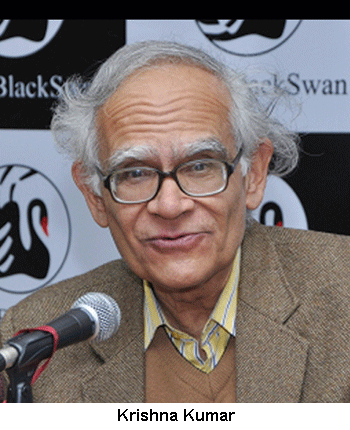The downside of beautiful schools – Krishna Kumar
 A visit to a high-end school starts with a security guard in the school’s livery greeting your driver at the high well-wrought gate. As your car drives in, you notice the lovely gardens with smooth, plush lawns, neatly trimmed hedges, flowering plants in prim gamlas placed in symmetrical patterns, ornamental trees and so on. This is just the beginning. After customary courtesies, the principal takes the visitor around to view the swimming pool, the basement gym, staff rooms for primary and secondary sections, the classrooms, the labs and, yes, the well-stocked library.
A visit to a high-end school starts with a security guard in the school’s livery greeting your driver at the high well-wrought gate. As your car drives in, you notice the lovely gardens with smooth, plush lawns, neatly trimmed hedges, flowering plants in prim gamlas placed in symmetrical patterns, ornamental trees and so on. This is just the beginning. After customary courtesies, the principal takes the visitor around to view the swimming pool, the basement gym, staff rooms for primary and secondary sections, the classrooms, the labs and, yes, the well-stocked library.
Latter-day top-ranked schools offer every possible facility needed to aspire for excellence. Moreover, the equipment is of the highest quality available in the market. The principal is eager to go into details: the tiles in the swimming pool, the stones paving the corridors, the teak banisters, and so on. The desks and chairs in the classroom aren’t just comfortable and age-appropriate, they are of world-class quality. The principal proudly tells you the management has decided to make every classroom smart. Not just the principals office, the staff room, the computer lab, but every classroom from nursery upwards, is air-conditioned. Finally, its time to start the ceremonies you have been invited to grace, so you are ushered into the auditorium. Its carpet, seats, the vast podium and noiseless air-conditioning speak of an institution steeped in prosperity and confidence.
By now, many readers of EducationWorld must have assumed that I intend to complain against the disparities that characterise our education system. No, this essay is not about the gap or contrasts we see between the infrastructure of government schools and what the top-ranked private schools provide. I want to focus on the culture of opulence and ostentation that has spread across the private school system over the past three decades. Older private schools like Doon and Welham valued graceful simplicity. But new private schools tend to choose the path of display and self-proclamation. Initially, it was just a craze for central air-conditioning. I recall an eminent, rich lawyer who had just transferred his children from a school in England to a private school in Delhi sometime in the mid-1990s telling me with dismay that the school was soon going to air-condition all the classrooms. Even the buses are air-conditioned, he said in disbelief. “How will my children learn about Indian life and relate to the wider social ethos if their schooling is going to be in such a cloistered environment? How will they experience the change of seasons?”
Twenty-five years on, those questions look rather silly and outdated. It is now part of the established culture of high-fee private schools to flaunt the five-star material comforts they provide to children. Annual day celebrations and other fests are occasions when the school showcases its wherewithal. The school magazine is printed on art paper, with visuals highlighting the display of status and resources. At admission time, advertisements in the media announce the new technologies of supervision and surveillance the school owns. CCTV cameras in classrooms also cover play spaces and every nook and corner, and are presented by way of reassurance that the school is committed to complete transparency and accountability. Parents can track their child from home or office throughout the school day, with the help of the latest monitoring devices. The principal, in turn, keeps a vigilant eye, from her office, on every teachers pedagogic performance.
It is difficult to say whether the principals and members of the management committees of these schools have any awareness of the most commonly known ideas about how children learn and grow up. One basic principle of learning is that an open, flexible and simpler ethos makes children feel relaxed and encourages them to be active and creative. Surveillance is a recipe for destroying pedagogic ingenuity and imagination which depend on a sense of freedom and autonomy.
A tightly structured, heavily technologised environment cannot promote the intellectual and emotional qualities education is supposed to nourish. Lush lawns and trimmed bushes in a school garden indicate a lost opportunity of letting children learn about nature by gardening with their own hands. Ideas like these are so basic that I feel a bit embarrassed writing about them in early 21st century in a magazine read by India’s most competitive schools. It is bizarre and dismaying that neither new educational entrepreneurs nor their agents — principals and teachers — understand children’s natural right to be messy and to have leisure. If early regimentation was the core of good education, India would have been on top of the world in education by now. Our beautifully maintained private schools must remember that child-centred education cannot be practised under surveillance. If they have any doubts, let them read any book they choose and find time for in their busy lives, by Montessori, Tagore or Elkind.
(Dr. Krishna Kumar is former director of NCERT and former professor of education at Delhi University)














Add comment